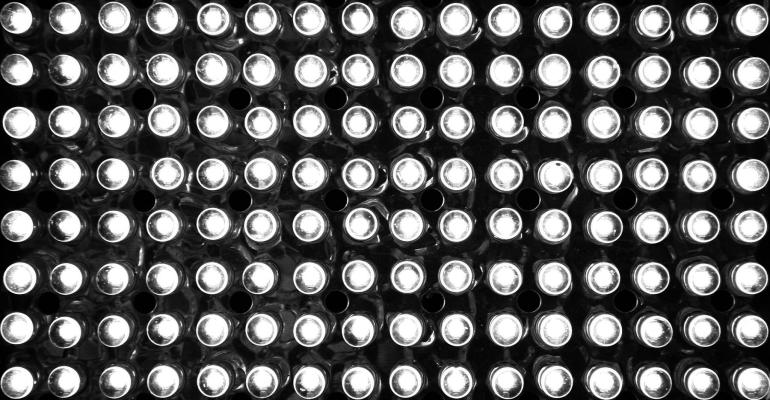In global conversations about the threat of rising greenhouse gas and global warming, the IT infrastructure industry is an often-cited culprit. The situation has not gone unnoticed in the IT community, with major efforts underway to curb energy use that have resulted in a flurry of new ideas and approaches to improve energy efficiency: better airflow management, hot aisle/cold aisle arrangements, variable-speed fans for equipment cooling, and consolidating lightly-used servers to name a few.
But more still needs to be done if data centers are to rein in their considerable energy usage. As such, an often overlooked, but extremely powerful player in the data center industry’s energy equation is gaining traction: LED lighting. Distributed low-voltage power and LED lighting are growing in popularity due to their various benefits, which go way beyond simply illuminating the space. One of the primary advantages is energy conservation. LED lights are far more energy efficient than traditional lighting.
Additionally, distributed low-voltage power eliminates the need for costly power distribution units and associated infrastructure, thereby reducing capital expenditures with the potential to save between $2 to $5 per sq.ft on materials and labor.
Let’s look at all the ways LED lighting can move the needle for efficiency in data center applications:
How LED Lighting Brings Sustainability
Data Center lighting design goes beyond simply illuminating the space. Distributed low-voltage power and LED lighting are rapidly gaining popularity in data centers thanks to their risk mitigation strategies and energy and waste efficiencies. The benefits of LED lighting for data centers includes the following:
Energy Conservation
LED lights are far more energy efficient than traditional lighting. Studies have shown that using energy-efficient technologies such as LED lighting can reduce data center lighting energy usage by up to 70%, which is good news for a data center’s overall power usage effectiveness (PUE).
LED lighting is also known to produce significantly less heat than alternative forms of lighting, which is ideal for temperature-sensitive server rooms. Because cooling represents a significant energy draw for data centers, the ability to deploy lighting systems that don’t contribute to hotter server rooms helps operators conserve energy from cooling and reduce associated cooling costs over time.
Energy-efficient LED lighting is a top choice for a variety of other industries and commercial settings and is championed by the US Department of Energy as a highly energy-efficient lighting technology that has the potential to fundamentally change the future of lighting in the US . The department projects widespread use in the near future, estimating that by 2035, a majority of lighting installations will use LED technology, resulting in up to 569 TWh of energy savings, or roughly the output of more than 92 1,000 MW power plants.
Temperature Control
Thanks to the advent of LED lights, lighting is safer, more efficient, and better able to withstand the heat generated in a data center’s interior.
These days, data centers are pushing the bounds of temperature control. Many are operating at higher and higher interior temperatures to lower energy costs. At the same time, computer chips operating the IT infrastructure have evolved to incorporate higher compute power, which generates more heat.
This trend is taking the industry from CPU to GPU and from 5 kW server racks to 15, 20 or 30-plus kW server racks. Even the ASHRAE standards themselves are evolving to meet the changing data center heat standards. Hot aisles are getting hotter, operating at 90-100+ degrees Fahrenheit. That makes energy-efficient solutions that are also certified to operate in excessive hot aisle temperature environments more important than ever.
Cost
Quality LED light bulbs last longer, are more durable, and offer comparable or better light quality than other types of lighting at a lower operating cost. In some cases, data centers can reduce the number of fixtures while still maintaining the same illumination levels, as we found in a recent exercise with a colocation data center. Distributed low-voltage power also eliminates the need for costly power distribution units and associated infrastructure, thereby reducing capital expenditures.
LED lighting also offers other benefits, including reduced maintenance time and enhanced safety.
Maintenance
Maintenance is another area where distributed low voltage power and LED lighting provide advantages due to LED lighting’s longer lifespan than traditional lighting. According to the US Department of Energy, a quality LED bulb can last three to five times longer than a compact fluorescent lamp (CFL) and 30 times longer than an incandescent bulb. Furthermore, distributed low-voltage power reduces the number of cables required, making it easier to manage and maintain the system. This, in turn, reduces the risk of downtime and improves system efficiency.
Safety
LED lighting along with distributed low-voltage power systems and power over ethernet (PoE) offer many safety benefits. LED lights produce less heat making them cooler and reducing the risk of combustion or burns. They are also constructed from break-resistant materials and do not contain any harmful chemicals. Additionally, the distributed low voltage power (DLVP) and PoE lighting of LED technology allows for remote control, enabling workers to maintain and operate the lights from a safe distance, reducing the likelihood of injury from electrical shocks and falls.
As data centers heed the call to take their power consumption more seriously, LED lighting provides an important resource for sustainability gains in previously overlooked areas within their infrastructure. Put simply, LEDs have a significantly longer lifespan than traditional lighting, offer enhanced safety features, and deliver comparable or better light quality than other types of lighting at a lower operating cost.
Sam Rabinowitz is CEO of Lantana LED.





